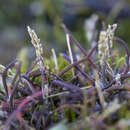Comprehensive Description
provided by North American Flora
Phippsia algida (Phipps) R. Br. Chlor. Melv. 27. 1823
Agrostis aliiiilii Phipps, Voy. 200. 1774.
Trichodium algidum R. & S. Syst. Veg. 2: 283. 1817. (Based on Agrostis algida Wahl. 1 1 lits;umas
A. algida Phipps].) Colpodiitm monandrum Trin. None Entdeck. 2: 37. 1821. (Based on Agrostis algida Phipps.) Vilfa algida Trin. Cram. I'nill. 159. 1824. (Based on Agrostis algida Phipps.) Vilfa monandr a Trin. Gram. LTnifl. 159. 1824. (Type from "Sin. Laurentii" [probably St. Lawrence
Island, Alaska], Chamisso.)
Culms densely tufted, glabrous, 2-10 cm. tall; sheaths loose, thin, glabrous; ligule thin, whitish, 1-2 mm. long; blades numerous, flat, lax, abruptly contracted at apex, 1-2 mm. wide; panicles narrow, 1-2 cm. long, the branches short, appressed, glabrous; spikelets 1.5-2 mm. long.
- bibliographic citation
- Albert Spear Hitchcock. 1937. (POALES); POACEAE (pars). North American flora. vol 17(7). New York Botanical Garden, New York, NY
Physical Description
provided by USDA PLANTS text
Perennials, Aquatic, leaves emergent, Terrestrial, not aquatic, Stems nodes swollen or brittle, Stems geniculate, decumbent, or lax, sometimes rooting at nodes, Stems solitary, Stems caespitose, tufted, or clustered, Stems terete, round in cross section, or polygonal, Stem internodes hollow, Stems with inflorescence less than 1 m tall, Stems, culms, or scapes exceeding basal leaves, Leaves mostly cauline, Leaves conspicuou sly 2-ranked, distichous, Leaves sheathing at base, Leaf sheath mostly closed, Leaf sheath smooth, glabrous, Leaf sheath and blade differentiated, Leaf sheath enlarged, inflated or distended, Leaf blades linear, Leaf blades very narrow or filiform, less than 2 mm wide, Leaf blades 2-10 mm wide, Leaf blades mostly flat, Leaf blades mostly glabrous, Ligule present, Ligule an unfringed eciliate membrane, Inflorescence terminal, Inflorescence a contracted panicle, narrowly paniculate, branches appressed or ascending, Inflorescence solitary, with 1 spike, fascicle, glomerule, head, or cluster per stem or culm, Inflorescence branches more than 10 to numerous, Lower panicle branches whorled, Flowers bisexual, Spikelets pedicellate, Spikelets sessile or subsessile, Spikelets laterally compressed, Spikelet less than 3 mm wide, Spikelets with 1 fertile floret, Spikelets 3 per node, Spikelets all alike and fertille, Spikelets bisexual, Spikelets disarticulating above the glumes, glume s persistent, Rachilla or pedicel glabrous, Glumes present, empty bracts, Glumes 1 clearly present, the other greatly reduced or absent, Glumes 2 clearly present, Glumes distinctly unequal, Glumes shorter than adjacent lemma, Lemma coriaceous, firmer or thicker in texture than the glumes, Lemma 3 nerved, Lemma glabrous, Lemma apex truncate, rounded, or obtuse, Lemma awnless, Lemma margins thin, lying flat, Lemma straight, Palea present, well developed, Palea membranous, hyaline, Palea about equal to lemma, Palea 2 nerved or 2 keeled, Palea keels winged, scabrous, or ciliate, Stamens 2, Styles 2-fid, deeply 2-branched, Stigmas 2, Fruit - caryopsis.

